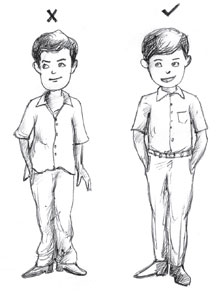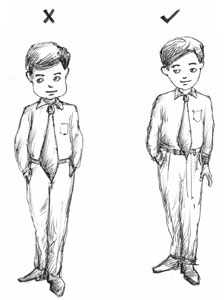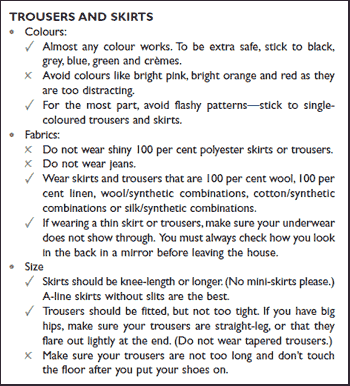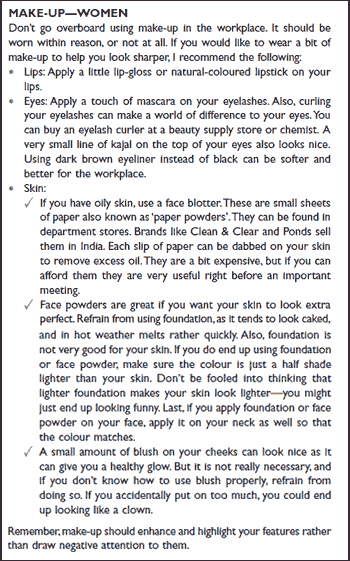Home »
Get Ahead » Is etiquette important? Does impression really matter?
Is etiquette important? Does impression really matter?
Last updated on: July 27, 2009
Image: Cover: You're Hired!
Good communication skills play a huge role in the recruitment process and job applicants who have weak skills are decidedly at a disadvantage. But what exactly are communication skills and how can you perfect yours well enough to get you your dream job?
Nasha Fitter, a teacher, entrepreneur and expert on communications and soft-skilled training, recently launched You're Hired! a book that helps job seekers improve their English communication and job placement skills.
Rediff.com will present a series of excerpts from the book over the coming weeks, and also feature chats with Nasha discussing the topics and intricacies of the job application process.
Here we present the seventh part of the series: Is etiquette important? Does impression really matter?
We all want to get the job of our dreams -- one that pays us more money and gives us more responsibility. But, to get a better job, we have to prove we are worthy of that job. To do so, our image really matters. How nicely we dress, how well we stand and look, how strongly we shake our interviewer's hand, how well we write our CV, and how professionally we talk to r ecruiters -- all this adds up to give us our image. In this section, you will learn how to create a more professional image for yourself and how to get the job of your dreams!
Excerpted from You're Hired! (Rs 199) by Nasha Fitter with the permission of publishers Penguin Books.
In this continuing series, we will be featuring excerpts from You're Hired! covering topics such as pronunciation, speech, accent, email, interpersonal communication and professional etiquette. Get useful interview tips at Nasha's blog: https://nashafitter.rediffiland.com. So if you need help with your job search and career, watch this space!

Image: Men: How to dress to impress
Before we begin, an important point -- you do not have to buy designer brands or spend a lot of money to look professional. All you need to do is avoid certain fabrics, choose certain colours and wear accessories correctly.
We will also go over some basic tips for dressing professionally at the workplace. Remember that every workplace will have its own rules. These are some general tips for looking sharp and appropriate in a business setting.
TROUSERS
- Colours:
- Stick to black, grey or dark blue.
- Fabrics:
- Do not wear 100 per cent cotton trousers to interviews as they wrinkle easily. Cotton khakis can be worn to work, but not to interviews or meetings.
- Do not wear shiny polyester trousers (100 per cent polyester trousers).
- Do not wear jeans to meetings and interviews.
- Wear trousers that are a combination of polyester/rayon or cotton/synthetic. While trousers that are 100 per cent wool, 100 per cent micro-synthetic and wool/synthetic combinations are very nice, they are impractical in a hot country like India.
- Size:
- Make sure your trousers fit well -- do not wear baggy trousers.
- Trousers should not be rolled at the end.
- Trousers should not be too long and not touch the floor when you walk.
- Trousers should also not be too short. Your socks should not be visible when you walk.
- Look at men's fashion magazines to get an idea of how good trousers should fit.
Excerpted from You're Hired! (Rs 199) by Nasha Fitter with the permission of publishers Penguin Books.
In this continuing series, we will be featuring excerpts from You're Hired! covering topics such as pronunciation, speech, accent, email, interpersonal communication and professional etiquette. Get useful interview tips at Nasha's blog: https://nashafitter.rediffiland.com. So if you need help with your job search and career, watch this space!

Image: Dressing to impress
UNDERSHIRTS
- Wear undershirts under collared shirts so that sweat does not seep through.
- Do not wear sleeveless undershirts.
SHOES
- Shoes should be black or brown. Avoid white and other lightcoloured shoes.
- If possible, buy leather shoes -- they are the best.
- No tennis shoes, sandals or slippers.
TIES
- Wear a tie to all interviews and meetings.
- Ties can be single coloured or multicoloured. If multicoloured, make sure that at least one of the colours on the tie is the same as your shirt or your trousers. Avoid ties with floral patterns, cartoon characters or anything too flashy.
- The tie should be knotted so that it is just long enough to touch the belt.
JACKETS
- It's best to take a suit jacket along with you for an interview. There is no harm in looking extra professional. Also, you can always take off your jacket if you are feeling hot, or if you feel you are overdressed. For an interview, make sure your jacket is the same fabric and colour as your trousers. If you are not going to an interview, your jacket and trousers can be different colours, like a black jacket and grey trousers. For meetings, ask your superior if you should take a jacket. For the most part, if you are wearing a tie, you don't really need to wear a jacket.
ACCESSORIES
- Trousers should always be worn with belts. Belts should not be wider than one inch and the colour should match your shoe colour (e.g. brown belt with brown shoes).
- Avoid large silver and gold buckles, as they are too flashy.
- A watch should be fitted, it should not dangle off your wrist like a bracelet.
- Don't wear sunglasses (on your face or on your head) for an interview or meeting.
Excerpted from You're Hired! (Rs 199) by Nasha Fitter with the permission of publishers Penguin Books.
In this continuing series, we will be featuring excerpts from You're Hired! covering topics such as pronunciation, speech, accent, email, interpersonal communication and professional etiquette. Get useful interview tips at Nasha's blog: https://nashafitter.rediffiland.com. So if you need help with your job search and career, watch this space!

Image: Dressing to impress
Here too, one thing is certain -- you do not have to buy designer brands and spend a lot of money to look professional. All you need to do is avoid certain fabrics, choose certain colours, and wear accessories correctly.
Let's go over some basic tips for dressing professionally at the workplace. Remember, every workplace will have its own rules. These are general tips for looking sharp and appropriate in a business setting.
Women can wear both western clothes and Indian clothes to the workplace. Let's first look at some tips for western clothes.
SHIRTS
- Style:
- Collared shirts, blouses or sweaters can be worn safely.
- Colour:
- Almost any colour works for women. To be extra professional stick to whites, blues, greys and cr mes.
- Try to avoid colours that are too distracting, like bright pink, bright orange and red.
- Single colours or patterns are both acceptable. If wearing patterns, stick to stripes, checks and simple designs. Avoid floral patterns.
- Fabric:
- When wearing collared shirts, wear 100 per cent cotton or cotton/synthetic combinations.
- When wearing blouses, wear cotton, synthetic and silks (any combination).
- When wearing sweaters, any material is fine.
- Avoid wearing shirts that are too thin -- your bra should not show through your shirt.
- Size:
- For interviews, long-sleeved shirts are always safe.
- For daily work, short sleeves are okay. Do not wear sleeveless shirts.
- Iron your shirts (especially collared shirts) before wearing them.
- Tuck in -- tucking your shirt in looks sharper. However, if you are on the heavier side, it will look better if you leave your shirt untucked. If you do leave your shirt untucked, make sure your shirt is not too long or too short. It should fall halfway down your hip.
- Try to match your shirts with your skirts and trousers. Look at women's fashion magazines for tips.
Let's now go over how you should dress if you are wearing Indian clothes.
Excerpted from You're Hired! (Rs 199) by Nasha Fitter with the permission of publishers Penguin Books.
In this continuing series, we will be featuring excerpts from You're Hired! covering topics such as pronunciation, speech, accent, email, interpersonal communication and professional etiquette. Get useful interview tips at Nasha's blog: https://nashafitter.rediffiland.com. So if you need help with your job search and career, watch this space!

Image: Grooming tips
SALWAR KAMEEZES
- Colour:
- Stick to simple prints. Complicated and flashy designs are not good in the workplace.
- Almost all colours are fine.
- Fabric:
- Wear 100 per cent cotton, 100 per cent silk, cotton/synthetic combinations, cotton/silk combinations.
- Do not wear 100 per cent synthetic material -- these kinds of salwar kameezes look too shiny, too thin and too tacky. You want to make sure that the fabric is thick.
SARIS
- Only wear a sari if you are already used to wearing one. If you cannot walk or sit gracefully in a sari, then don't wear one to an interview or a meeting.
- Colours:
- Stick to simple prints. Complicated and flashy designs are distracting at the workplace.
- Almost all colours are fine -- just avoid distracting colours like bright pink, bright orange and red.
-
Fabric:
-
Wear 100 per cent cotton, 100 per cent silk, cotton/silk combinations or chiffon.
-
Do not wear synthetic saris. They look too shiny, too thin and too tacky. You want to make sure the fabric is thick.
-
Blouse:
Now, lets go over shoes and the other accessories that go with both western and Indian clothes.
SHOES
- When wearing western clothes, you must wear close-toed shoes.
- When wearing Indian clothes, open-toed sandals are acceptable.
- Leather shoes are the best, but other materials will do.
- Stick to dark-coloured shoes. Avoid white and light coloured shoes.
Heels are nice, but only wear them if you can walk in them properly. - Do not wear tennis shoes or slippers.
ACCESSORIES
- Subtle jewellery should be worn.
- One necklace, three rings or less (total, not per hand) and small earrings are acceptable.
- Avoid wearing too much gold.
- No bangles -- one simple bracelet is more professional.
- Scarves are nice accessories and are fashionable. Only wear them if you can match them properly with your outfit.
- Belts are nice accessories when you are wearing trousers. Make sure the buckle is not too big. If you are wearing gold jewellery, make sure the buckle is gold. If you are wearing silver jewellery, make sure the buckle is silver.
- Make sure your purse looks professional. Do not go to an interview with a pink, synthetic purse you took to a party the night before.
- Don't wear sunglasses (on your face or on your head) for an interview or important meeting.
Excerpted from You're Hired! (Rs 199) by Nasha Fitter with the permission of publishers Penguin Books.
In this continuing series, we will be featuring excerpts from You're Hired! covering topics such as pronunciation, speech, accent, email, interpersonal communication and professional etiquette. Get useful interview tips at Nasha's blog: https://nashafitter.rediffiland.com. So if you need help with your job search and career, watch this space!




